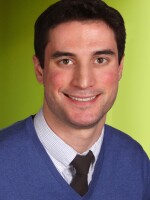The window blinds control themselves, adjusting automatically to light conditions.
The roof is covered with plants.
Each cubicle has its own individual climate control system.
Ed Bogucz and his colleagues are guinea pigs, working inside a giant, building-sized science experiment: the Syracuse Center of Excellence.
Bogucz is the director of the Center of Excellence (CoE), which focuses on energy and environmental systems. The high tech building, just on the other side of downtown from Interstate 81, opened two years ago this month.
The building is a living, breathing test site for the future of energy. But it wasn’t always this way. The CoE existed for eight years before finding a place to call home.
Started by the state in 2002, six Centers of Excellence, each with a different focus area, are located throughout the state. They were set up to encourage innovation and the commercialization of scientific research, including connecting academic institutions with private enterprise.
Bruce Kingma knows a thing or two about that. As Syracuse University’s associate provost for entrepreneurship and innovation, he’s working with the CoE to start a green entrepreneurship program.
“It is an incredibly important organization. Not only in the world of sustainability, but the world of entrepreneurship,” says Kingma on why he partners with the CoE. “So it’s sort of that intersection of entrepreneurship, sustainability and university.”
CoE’s unusual headquarters has increased its prominence, says Kingma. Not all of the Centers of Excellence have such a place to call their own.
The CoE’s role as an intersection means it often hosts meetings and events at the headquarters. But in between, the building can feel empty.
Many work spaces and conference rooms sit empty, ready for people to come use them. But Bogucz counters that a single visit to his building can’t truly capture how it’s used.
“It’s kind of like the gym,” he says with a chuckle. “You come to the gym to work out, you come to our headquarters to use the labs because we have some unique equipment and we can do some things here that people can’t do on their own campuses or at their own companies.”
Room to grow
A large room on the bottom of the CoE sits mostly empty right now. Large wooden block lying around give it the feel of a warehouse.
Those blocks will soon be put together for a new study to be done in the building.
A large part of the space will also be dedicated to a biofuels research laboratory, which will be used by SUNY College of Environmental Science and Forestry professor Michael Kelleher.
Kelleher’s lab has been held up due to funding. He suspects his is not the only project that’s had this problem since the CoE opened two years ago.
“I think there’s a little bit of a challenge just sort of where we are in the economy as far as funding opportunities,” says Kelleher, who runs SUNY-ESF’s renewable energy program. “So it may not be as utilized as it could be if the economic conditions were different.”
As the laboratory wing is poised for new additions, Syracuse University’s Kingma foresees more growth for the CoE.
“There’s sort of explosive potential now of that building and I think that amazing things will happen over the next one, two, three years.”






